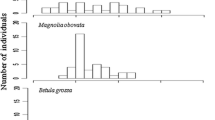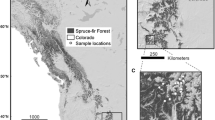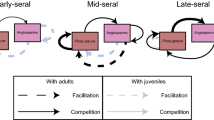Abstract
The Colchic rainforest of the Western Caucasus is one of the few temperate rainforests dominated by broadleaf deciduous trees. Understanding natural dynamics of broadleaf-dominated temperate rainforests is essential for their conservation and management. Here, we investigate for the first time the structure, natural disturbance, and recruitment dynamics of a mixed Colchic old-growth rainforest, dominated by Fagus orientalis and Picea orientalis. We used forest inventories and dendrochronological analysis of tree growth in five 30-m-radius plots to quantify forest structure, growth, and disturbances. For the last 400 years, the forest experienced a mixed disturbance regime dominated by frequent small gaps superimposed onto medium disturbances with about a 25-year recurrence period, with no evidences of stand-replacing disturbances. This disturbance regime favored the dominance of shade-tolerant, late successional species with slow tree canopy access through multiple growth releases. These dynamics impose low growth rates and continuous recruitment of spruce and beech, and contributed to a high heterogeneity of tree ages and sizes that result in stable forest structure, as suggested by the low stand slenderness. Spruces were the oldest (up to 427 years) and fastest growing trees in the forest, suggesting that their low presence in the forest is due to low disturbance rates that limit their recruitment. Spring climate conditions that promoted beech growth were detrimental for spruce growth, suggesting that interspecies interactions may condition the effect of climate on forest growth and development. The dynamic equilibrium state we reconstructed in this old-growth forest could likely be disrupted by anthropogenic disturbances or management.







Similar content being viewed by others
References
Altman J, Fibich P, Dolezal J, Aakala T. 2014. TRADER: a package for tree ring analysis of disturbance events in R. Dendrochronologia 32:107–12.
Alton PB. 2008. Reduced carbon sequestration in terrestrial ecosystems under overcast skies compared to clear skies. Agric For Meteorol 148:1641–53.
Atici E, Colak AH, Rotherham ID. 2008. Coarse dead wood volume of managed oriental beech (Fagus orientalis Lipsky) stands in Turkey. Investigación agraria Sistemas y recursos forestales 17:216–27.
Babst F, Poulter B, Trouet V, Kun T, Neuwirth B, Wilson R, Carrer M, Grabner M, Tegel W, Levanic T, Panayotov M, Urbinati C, Bouriaud O, Ciais P, Frank D. 2013. Site and species-specific responses of forest growth to climate across the European continent. Glob Ecol Biogeogr 22:706–17.
Baker PJ. 2003. Tree age estimation for the tropics: a test from the southern Appalachians. Ecol Appl 13:1718–32.
Bigler C, Veblen TT. 2009. Increased early growth rates decrease longevities of conifers in subalpine forests. Oikos 118:1130–8.
Browicz K. 1989. Chorology of the Euxinian and Hyrcanian element in the woody flora of Asia. Plant Syst Evol 162:305–14.
Bunn AG. 2008. A dendrochronology program library in R (dplR). Dendrochronologia 26:115–24.
Busing RT, Clebsch EEC, White PS. 1993. Biomass and production of southern Appalachian cove forests reexamined. Can J For Res 23:760–5.
Canham CD. 1988. Growth and canopy architecture of shade-tolerant trees: response to canopy gaps. Ecology 69:786–95.
Carrer M, Castagneri D, Popa I, Pividori M, Lingua E. 2018. Tree spatial patterns and stand attributes in temperate forests: the importance of plot size, sampling design, and null model. For Ecol Manag 407:125–34.
Commarmot B, Bachofen H, Bundziak Y, Bürgi A, Ramp B, Shparyk Y, Sukhariuk D, Viter R, Zingg A. 2005. Structures of virgin and managed beech forests in Uholka (Ukraine) and Sihlwald (Switzerland): a comparative study. For Snow Landsc Res 79:45–56.
Cook ER. 1985. A time series analysis approach to tree-ring standardization. Tucson: University of Arizona.
Daniels LD, Gray RW. 2006. Disturbance regimes in coastal British Columbia. J Ecosyst Manag 7:44–56.
Davis SC, Hessl AE, Scott CJ, Adams MB, Thomas RB. 2009. Forest carbon sequestration changes in response to timber harvest. For Ecol Manag 258:2101–9.
DellaSala DA, Alaback P, Spribille T, Wehrden H, Nauman RS. 2011. Just what are temperate and boreal rainforests? Temperate and boreal rainforests of the world: ecology and conservation. Washington: Island Press/Center for Resource Economics. pp 1–41.
Di Filippo A, Biondi F, Piovesan G, Ziaco E, Butt N. 2016. Tree ring-based metrics for assessing old-growth forest naturalness. J Appl Ecol 54:737–49.
Dolman AJ, Moors EJ, Elbers JA. 2002. The carbon uptake of a mid latitude pine forest growing on sandy soil. Agric For Meteorol 111:157–70.
Druckenbrod DL, Martin-Benito D, Orwig DA, Pederson N, Poulter B, Renwick KM, Shugart HH. 2019. Redefining temperate forest responses to climate and disturbance in the eastern United States: new insights at the mesoscale. Glob Ecol Biogeogr 28:557–75.
Durkaya B, Durkaya A, Önal G, Kaptan S. 2018. Evaluation of the effects of various factors on aboveground and belowground biomass storage capacity of Rhododendron ponticum. BOSQUE 39:95–106.
Dye A, Ross Alexander M, Bishop D, Druckenbrod D, Pederson N, Hessl A. 2019. Size-growth asymmetry is not consistently related to productivity across an eastern US temperate forest network. Oecologia 189:515–28.
Eminağaoğlu Ö, Kutbay HG, Özkan ZC, Ergül A. 2008. Flora of the Camili Biosphere Reserve Area (Borçka, Artvin, Turkey). Turk J Bot 32:43–90.
Ensminger I, Sveshnikov D, Campbell DA, Funk C, Jansson S, Lloyd J, Shibistova O, Öquist G. 2004. Intermittent low temperatures constrain spring recovery of photosynthesis in boreal Scots pine forests. Glob Change Biol 10:995–1008.
Ercanli İ, KahrİMan A, Yavuz H. 2014. Dynamic base-age invariant site index models based on generalized algebraic difference approach for mixed Scots pine (Pinus sylvestris L.) and Oriental beech (Fagus orientalis Lipsky) stands. Turk J Agric For 38:134–47.
Eşen D, Zedaker SM, Kirwan JL, Mou P. 2004. Soil and site factors influencing purple-flowered rhododendron (Rhododendron ponticum L.) and eastern beech forests (Fagus orientalis Lipsky) in Turkey. For Ecol Manag 203:229–40.
Eşen D, Soysal GE, Yıldız O. 2015. Regenerating eastern beech (Fagus orientalis Lipsky) with gaps of various sizes in the Western Black Sea Region of Turkey. D.Ü. Ormancılık Dergisi 11:71–82.
Fraver S, White AS, Seymour RS. 2009. Natural disturbance in an old-growth landscape of northern Maine, USA. J Ecol 97:289–98.
Frelich LE, Reich PB. 2003. Perspectives on development of definitions and values related to old-growth forests. Environ Rev 11:S9–22.
Grassi G, Bagnaresi U. 2001. Foliar morphological and physiological plasticity in Picea abies and Abies alba saplings along a natural light gradient. Tree Physiol 21:959–67.
Gutiérrez AG, Armesto JJ, Aravena JC. 2004. Disturbance and regeneration dynamics of an old-growth North Patagonian rain forest in Chiloé Island, Chile. J Ecol 92:598–608.
Gutiérrez AG, Armesto JJ, Aravena J-C, Carmona M, Carrasco NV, Christie DA, Peña M-P, Pérez C, Huth A. 2009. Structural and environmental characterization of old-growth temperate rainforests of northern Chiloé Island, Chile: regional and global relevance. For Ecol Manag 258:376–88.
Hashemi SA. 2011. Evaluating beech phenology in a natural mountain forest using ground observation and satellite data. Curr Res J Biol Sci 3:56–63.
Haylock MR, Hofstra N, Klein Tank AMG, Klok EJ, Jones PD, New M. 2008. A European daily high-resolution gridded data set of surface temperature and precipitation for 1950–2006. J Geophys Res Atmos 113:D20119.
Holmes RL. 1983. Computer-assisted quality control in tree-ring dating and measurement. Tree Ring Bull 43:69–78.
Jackson T, Shenkin A, Kalyan B, Zionts J, Calders K, Origo N, Disney M, Burt A, Raumonen P, Malhi Y. 2019. A new architectural perspective on wind damage in a natural forest. Front For Glob Change 1:1–13.
Jactel H, Brockerhoff E, Duelli P (2005) A test of the biodiversity-stability theory: meta-analysis of tree species diversity effects on insect pest infestations, and re-examination of responsible factors. In: Forest diversity and function. Berlin: Springer. pp 235–262.
Kahriman A, Altun L, Güvendi E. 2016. Determination of stand structure in even-aged Oriental Beech Forests in Turkey. Bosque (Valdivia) 37:557–69.
Kayacik H. 1955. The distribution of Picea orientalis (L.) Carr. Kew Bull 10:481–90.
Keith H, Mackey BG, Lindenmayer DB. 2009. Re-evaluation of forest biomass carbon stocks and lessons from the world’s most carbon-dense forests. Proc Natl Acad Sci U S A 106:11635–40.
Khapayev SA. 1978. Dynamics of avalanche natural complexes: an example from the high-mountain Teberda State Reserve, Caucasus Mountains, USSR. Arct Alp Res 10:335–44.
Lawrimore JH, Menne MJ, Gleason BE, Williams CN, Wuertz DB, Vose RS, Rennie J. 2011. An overview of the global historical climatology network monthly mean temperature data set, version 3. J Geophys Res 116:D19121.
Lertzman KP, Sutherland GD, Inselberg A, Saunders SC. 1996. Canopy gaps and the landscape mosaic in a coastal temperate rain forest. Ecology 77:1254–70.
Lorimer C, Frelich L. 1989. A methodology for estimating canopy disturbance frequency and intensity in dense temperate forest. Can J For Res 19:651–63.
Luyssaert S, Schulze ED, Börner A, Knohl A, Hessenmöller D, Law BE, Ciais P, Grace J. 2008. Old-growth forests as global carbon sinks. Nature 455:213.
Martin-Benito D, Pederson N, Köse N, Doğan M, Bugmann H, Mosulishvili M, Bigler C. 2018. Pervasive effects of drought on tree growth across a wide climatic gradient in the temperate forests of the Caucasus. Glob Ecol Biogeogr 27:1314–25.
Mosseler A, Lynds JA, Major JE. 2003. Old-growth forests of the Acadian Forest Region. Environ Rev 11:S47–77.
Muukkonen P. 2007. Generalized allometric volume and biomass equations for some tree species in Europe. Eur J For Res 126:157–66.
Nagel TA, Mikac S, Dolinar M, Klopcic M, Keren S, Svoboda M, Diaci J, Boncina A, Paulic V. 2016. The natural disturbance regime in forests of the Dinaric Mountains: a synthesis of evidence. For Ecol Manag 388:29–42.
Nehrbass-Ahles C, Babst F, Klesse S, Nötzli M, Bouriaud O, Neukom R, Dobbertin M, Frank D. 2014. The influence of sampling design on tree-ring-based quantification of forest growth. Glob Change Biol 20:2867–85.
Nippert JB, Duursma RA, Marshall JD. 2004. Seasonal variation in photosynthetic capacity of montane conifers. Funct Ecol 18:876–86.
Oliver CD, Larson BC. 1996. Forest stand dynamics: updated edition. Hoboken: Wiley.
Ottander C, Öquist G. 1991. Recovery of photosynthesis in winter-stressed Scots pine. Plant Cell Environ 14:345–9.
Parhizkar P, Sagheb-Talebi K, Mataji A, Nyland R, Namiranian M. 2011. Silvicultural characteristics of Oriental beech (Fagus orientalis Lipsky) regeneration under different RLI and positions within gaps. Forestry 84:177–85.
Pederson N, Dyer JM, McEwan RW, Hessl AE, Mock C, Orwig D, Rieder HE, Cook BI. 2014. The legacy of episodic climatic events in shaping broadleaf-dominated forests. Ecol Monogr 599–620:599–620.
Pederson N, Young AB, Stan AB, Ariya U, Martin-Benito D. 2017. Low-hanging dendrodynamic fruits regarding disturbance in temperate, mesic forests. In: Amoroso MM, Daniels LD, Baker PJ, Camarero JJ, Eds. Dendroecology: tree-ring analyses applied to ecological studies. Cham: Springer. p 97–134.
Pickett STA, Kolasa J, Armesto JJ, Collins SL. 1989. The ecological concept of disturbance and its expression at various hierarchical levels. Oikos 129–136
Piovesan G, Filippo AD, Alessandrini A, Biondi F, Schirone B. 2005. Structure, dynamics and dendroecology of an old-growth Fagus Forest in the Apennines. J Veg Sci 16:13–28.
Pollmann W. 2003. Stand structure and dendroecology of an old-growth Nothofagus forest in Conguillio National Park, south Chile. For Ecol Manag 176:87–103.
Pretzsch H, Schutze G. 2005. Crown allometry and growing space efficiency of Norway spruce (Picea abies [L.] Karst.) and European beech (Fagus sylvatica L.) in pure and mixed stands. Plant Biol (Stuttg) 7:628–39.
R Development Core Team (2017) R: a language and environment for statistical computing. R Foundation for Statistical Computing, Vienna, Austria. http://www.r-project.org/.
Rademacher C, Neuert C, Grundmann V, Wissel C, Grimm V. 2004. Reconstructing spatiotemporal dynamics of Central European natural beech forests: the rule-based forest model BEFORE. For Ecol Manag 194:349–68.
Rötzer T, Grote R, Pretzsch H. 2004. The timing of bud burst and its effect on tree growth. Int J Biometeorol 48:109–18.
Sefidi K, Marvie Mohadjer MR, Mosandl R, Copenheaver CA. 2011. Canopy gaps and regeneration in old-growth Oriental beech (Fagus orientalis Lipsky) stands, northern Iran. For Ecol Manag 262:1094–9.
Seidl R, Thom D, Katz M, Martin-Benito D, Peltoniemi M, Vacchiano G, Wild J, Ascoli D, Petr M, Honkaniemi J, Lexer MJ, Trotsiuk V, Mairota P, Svoboda M, Fabrika M, Nagel TA, Reyer CPO. 2017. Forest disturbances under climate change. Nat Clim Change 7:395–402.
Shugart HH. 1984. A theory of forest dynamics: the ecological implications of forest succession models. New York: Springer.
Sivrikaya F, Çakir G, Kadioğullari Aİ, Keleş S, Başkent EZ, Terzioğlu S. 2007. Evaluating land use/land cover changes and fragmentation in the Camili forest planning unit of northeastern Turkey from 1972 to 2005. Land Degrad Dev 18:383–96.
Sönmez T, Çakıroğlu S. 2012. Using single and double entry tree volume tables calculation stand volume increment for picea orientalis stands according to the Meyer’s interpolation method. Artvin Coruh UEniversitesi Orman Fakueltesi Dergisi 13:226–34.
Stephenson NL, Das AJ, Condit R, Russo SE, Baker PJ, Beckman NG, Coomes DA, Lines ER, Morris WK, Ruger N, Alvarez E, Blundo C, Bunyavejchewin S, Chuyong G, Davies SJ, Duque A, Ewango CN, Flores O, Franklin JF, Grau HR, Hao Z, Harmon ME, Hubbell SP, Kenfack D, Lin Y, Makana JR, Malizia A, Malizia LR, Pabst RJ, Pongpattananurak N, Su SH, Sun IF, Tan S, Thomas D, van Mantgem PJ, Wang X, Wiser SK, Zavala MA. 2014. Rate of tree carbon accumulation increases continuously with tree size. Nature 507:90–3.
Stokes MA, Smiley TL. 1968. An introduction to tree-ring dating. Chicago: University of Chicago Press.
Trotsiuk V, Svoboda M, Weber P, Pederson N, Klesse S, Janda P, Martin-Benito D, Mikolas M, Seedre M, Bace R, Mateju L, Frank D. 2016. The legacy of disturbance on individual tree and stand-level aboveground biomass accumulation and stocks in primary mountain Picea abies forests. For Ecol Manag 373:108–15.
Trotsiuk V, Pederson N, Druckenbrod DL, Orwig DA, Bishop DA, Barker-Plotkin A, Fraver S, Martin-Benito D. 2018. Testing the efficacy of tree-ring methods for detecting past disturbances. For Ecol Manag 425:59–67.
Veblen TT, Alaback PB. 1996. A comparative review of forest dynamics and disturbance in the temperate rainforests of north and south America. In: Lawford RG, Fuentes E, Alaback PB, Eds. High-latitude rainforests and associated ecosystems of the west coast of the Americas: climate, hydrology, ecology, and conservation. New York: Springer. p 173–213.
Villalba R, Veblen TT. 1997. Improving estimates of total tree ages based on increment core samples. Ecoscience 4:534–42.
Vitasse Y, Delzon S, Dufrêne E, Pontailler J-Y, Louvet J-M, Kremer A, Michalet R. 2009. Leaf phenology sensitivity to temperature in European trees: do within-species populations exhibit similar responses? Agric For Meteorol 149:735–44.
Whittaker RH. 1966. Forest dimensions and production in the Great Smoky Mountains. Ecology 47:103–21.
Wiens JA. 1989. Spatial scaling in ecology. Funct Ecol 3:385–97.
Wirth C, Messier C, Bergeron Y, Frank D, Fankhänel A. 2009. Old-growth forest definitions: a pragmatic view. In: Wirth C, Gleixner G, Heimann M, Eds. Old-growth forests. Berlin: Springer. p 11–33.
Woods KD. 2004. Intermediate disturbance in a late-successional hemlock-northern hardwood forest. J Ecol 92:464–76.
Yamaguchi DK. 1991. A simple method for cross-dating increment cores from living trees. Can J For Res 21:414–16.
Yücesan Z, Özçelik S, Oktan E. 2015. Effects of thinning on stand structure and tree stability in an afforested oriental beech (Fagus orientalis Lipsky) stand in northeast Turkey. J For Res 26:123–9.
Zang C, Biondi F. 2015. treeclim: an R package for the numerical calibration of proxy-climate relationships. Ecography 38:431–6.
Zazanashvili N, Gagnidze R, Nakhutsrishvili G. 2000. Main types of vegetation zonation on the mountains of the Caucasus. Acta Phytogeogr Suec 85:7–16.
Zianis D, Mencuccini M. 2003. Aboveground biomass relationships for beech (Fagus moesiaca Cz.) trees in Vermio Mountain, Northern Greece, and generalised equations for Fagus sp. Ann For Sci 60:439–48.
Acknowledgements
We thank Daniel Bishop, Marco Mina, and Timothy Thrippleton for their help during fieldwork. In addition, we are also grateful to Cengiz Cihan and the Turkish General Directorate of Forestry (OGM) in Borçka, Artvin, for sampling permission and assistance in the field. Dario Martin-Benito was funded by Marie-Curie IEF Grant (EU-Grant 329935), ETH Zurich fund PA2350-404, and a project AGL2015-73190-JIN from the Spanish Ministry of Economy, Industry and Competitiveness. Mehmet Doğan was partly supported by TÜBİTAK (the Scientific and Technological Research Council of Turkey) International Postdoctoral Research Fellowship Programme (Grant No. 1059B191600826). The Climate Center of the Lamont-Doherty Earth Observatory at Columbia University provided funds for the exploratory work of this study. The datasets generated and analyzed in the current study are available from the corresponding author on reasonable request.
Author information
Authors and Affiliations
Corresponding author
Electronic Supplementary Material
Below is the link to the electronic supplementary material.
Rights and permissions
About this article
Cite this article
Martin-Benito, D., Pederson, N., Lanter, C. et al. Disturbances and Climate Drive Structure, Stability, and Growth in Mixed Temperate Old-growth Rainforests in the Caucasus. Ecosystems 23, 1170–1185 (2020). https://doi.org/10.1007/s10021-019-00462-x
Received:
Accepted:
Published:
Issue Date:
DOI: https://doi.org/10.1007/s10021-019-00462-x




